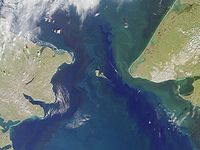Bering Strait: Difference between revisions
| Line 26: | Line 26: | ||
*{{cite news |
*{{cite news |
||
|url=http://www.beringstraitcrossing.com |
|url=http://www.beringstraitcrossing.com |
||
|title=The Bering Strait Crossing" by James A. Oliver |
|title=The Bering Strait Crossing" by James A. Oliver ISBN 0954699564 |
||
|publisher=Information Architects |
|publisher=Information Architects |
||
|date=2006 & 2007 (Revised)}} |
|date=2006 & 2007 (Revised)}} |
||
Revision as of 09:47, 14 May 2007



The Bering Strait (Russian: Берингов пролив) is a sea strait between Cape Dezhnev, Russia, the easternmost point (169°43' W) of the Asian continent and Cape Prince of Wales, Alaska, the westernmost point (168°05' W) of the North American continent, with latitude of about 65° 40' North, slightly south of the polar circle.
The strait is approximately 92 km (58 miles) wide, with a depth of 30–50 m (100–165 ft) and connects the Chukchi Sea (part of the Arctic Ocean) in the north with the Bering Sea (part of the Pacific Ocean) in the south. Although the Cossack Semyon Dezhnev passed by the strait in 1648, it is named after Vitus Bering, a Danish-born Russian explorer who crossed the strait in 1728.
The area is sparsely populated. The Diomede Islands lie directly in the middle of the Bering Strait, and the village of Little Diomede has a school which is part of Alaska's Bering Strait School District. The Russian side is 21 hours ahead of the American side, and so on a different day.
The area in the immediate neighbourhood on the Alaskan side belongs to the Nome Census Area, which has a population of 9,000 people. There is no road from the Bering strait to the main cities of Alaska. Air is the main mode of travel. There are a few roads around Nome. However there is no regular air connection across the strait, just a few summer charter flights. This is because of a Russian policy only to allow tourists in organised tours, and with special permit to everyone.
The Russian coast belongs to Chukotka Autonomous Okrug. Provideniya (4,500 people) and Chukotsky (5200 people) are the two areas located at the Bering Strait. These areas are also roadless.
Suggestions have been made for the construction of a bridge, the Bering Strait bridge, between Alaska and Siberia. An alternative connection would be a tunnel underneath the strait, the TKM-World Link being the most recent such proposal.
The land bridge that existed over the Bering Strait during the Ice Ages is known now as the Bering Land Bridge. Some scientists believe that so much water was stored as ice that the sea level dropped, exposing more land. Other scientists believe that during the ice age this strait was frozen over. This would have allowed Homo sapiens and other animals to cross.
In March 2006 Briton Karl Bushby and French American adventurer Dimitri Kieffer crossed the strait on foot, walking across a frozen 90 km (56 mile) section in 15 days. (BBC) (although they were soon arrested for not entering Russia through a border control.)
Actor Ewan MacGregor said in an interview on The Tonight Show with Jay Leno that part of the inspiration for his Long Way Round motorcycle journey from London to New York was that, when viewed on a map, the gap between Russia and the USA across the Bering Strait was in fact very small. MacGregor and his team ultimately crossed the strait with their motorcyles loaded onto a Magadan Airlines plane, flying from Magadan, Russia to Anchorage, Alaska.
As of April 2007, there has been talk of building a tunnel that would connect Alaska and Russia via the Bering Strait. The talk stems from a dream that goes back more than a century. The highway project is estimated to cost $65 billion and take 20 years to complete. The proposed tunnel will span 68 miles and run under water up to 180 feet deep. Plans include construction of road for vehicle travel, a rail line, oil/gas pipes, electricity, and fiber-optic cables within the tunnel. Some believe that up to 3% of the world’s cargo could eventually be moved through the tunnel. Even though the technology to build the tunnel is available, a $120 million feasibility study remains to be conducted before the project will begin.
References
- "The Bering Strait Crossing" by James A. Oliver ISBN 0954699564". Information Architects. 2006 & 2007 (Revised).
{{cite news}}: Check date values in:|date=(help)
http://www.cnn.com/2007/WORLD/europe/04/24/russia.alaska.tunnel.ap/index.html
